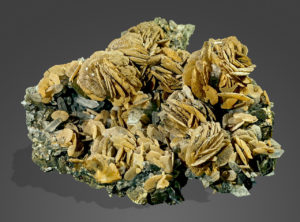1.4: Classifying Minerals
- Page ID
- 17526
\( \newcommand{\vecs}[1]{\overset { \scriptstyle \rightharpoonup} {\mathbf{#1}} } \)
\( \newcommand{\vecd}[1]{\overset{-\!-\!\rightharpoonup}{\vphantom{a}\smash {#1}}} \)
\( \newcommand{\dsum}{\displaystyle\sum\limits} \)
\( \newcommand{\dint}{\displaystyle\int\limits} \)
\( \newcommand{\dlim}{\displaystyle\lim\limits} \)
\( \newcommand{\id}{\mathrm{id}}\) \( \newcommand{\Span}{\mathrm{span}}\)
( \newcommand{\kernel}{\mathrm{null}\,}\) \( \newcommand{\range}{\mathrm{range}\,}\)
\( \newcommand{\RealPart}{\mathrm{Re}}\) \( \newcommand{\ImaginaryPart}{\mathrm{Im}}\)
\( \newcommand{\Argument}{\mathrm{Arg}}\) \( \newcommand{\norm}[1]{\| #1 \|}\)
\( \newcommand{\inner}[2]{\langle #1, #2 \rangle}\)
\( \newcommand{\Span}{\mathrm{span}}\)
\( \newcommand{\id}{\mathrm{id}}\)
\( \newcommand{\Span}{\mathrm{span}}\)
\( \newcommand{\kernel}{\mathrm{null}\,}\)
\( \newcommand{\range}{\mathrm{range}\,}\)
\( \newcommand{\RealPart}{\mathrm{Re}}\)
\( \newcommand{\ImaginaryPart}{\mathrm{Im}}\)
\( \newcommand{\Argument}{\mathrm{Arg}}\)
\( \newcommand{\norm}[1]{\| #1 \|}\)
\( \newcommand{\inner}[2]{\langle #1, #2 \rangle}\)
\( \newcommand{\Span}{\mathrm{span}}\) \( \newcommand{\AA}{\unicode[.8,0]{x212B}}\)
\( \newcommand{\vectorA}[1]{\vec{#1}} % arrow\)
\( \newcommand{\vectorAt}[1]{\vec{\text{#1}}} % arrow\)
\( \newcommand{\vectorB}[1]{\overset { \scriptstyle \rightharpoonup} {\mathbf{#1}} } \)
\( \newcommand{\vectorC}[1]{\textbf{#1}} \)
\( \newcommand{\vectorD}[1]{\overrightarrow{#1}} \)
\( \newcommand{\vectorDt}[1]{\overrightarrow{\text{#1}}} \)
\( \newcommand{\vectE}[1]{\overset{-\!-\!\rightharpoonup}{\vphantom{a}\smash{\mathbf {#1}}}} \)
\( \newcommand{\vecs}[1]{\overset { \scriptstyle \rightharpoonup} {\mathbf{#1}} } \)
\( \newcommand{\vecd}[1]{\overset{-\!-\!\rightharpoonup}{\vphantom{a}\smash {#1}}} \)
\(\newcommand{\avec}{\mathbf a}\) \(\newcommand{\bvec}{\mathbf b}\) \(\newcommand{\cvec}{\mathbf c}\) \(\newcommand{\dvec}{\mathbf d}\) \(\newcommand{\dtil}{\widetilde{\mathbf d}}\) \(\newcommand{\evec}{\mathbf e}\) \(\newcommand{\fvec}{\mathbf f}\) \(\newcommand{\nvec}{\mathbf n}\) \(\newcommand{\pvec}{\mathbf p}\) \(\newcommand{\qvec}{\mathbf q}\) \(\newcommand{\svec}{\mathbf s}\) \(\newcommand{\tvec}{\mathbf t}\) \(\newcommand{\uvec}{\mathbf u}\) \(\newcommand{\vvec}{\mathbf v}\) \(\newcommand{\wvec}{\mathbf w}\) \(\newcommand{\xvec}{\mathbf x}\) \(\newcommand{\yvec}{\mathbf y}\) \(\newcommand{\zvec}{\mathbf z}\) \(\newcommand{\rvec}{\mathbf r}\) \(\newcommand{\mvec}{\mathbf m}\) \(\newcommand{\zerovec}{\mathbf 0}\) \(\newcommand{\onevec}{\mathbf 1}\) \(\newcommand{\real}{\mathbb R}\) \(\newcommand{\twovec}[2]{\left[\begin{array}{r}#1 \\ #2 \end{array}\right]}\) \(\newcommand{\ctwovec}[2]{\left[\begin{array}{c}#1 \\ #2 \end{array}\right]}\) \(\newcommand{\threevec}[3]{\left[\begin{array}{r}#1 \\ #2 \\ #3 \end{array}\right]}\) \(\newcommand{\cthreevec}[3]{\left[\begin{array}{c}#1 \\ #2 \\ #3 \end{array}\right]}\) \(\newcommand{\fourvec}[4]{\left[\begin{array}{r}#1 \\ #2 \\ #3 \\ #4 \end{array}\right]}\) \(\newcommand{\cfourvec}[4]{\left[\begin{array}{c}#1 \\ #2 \\ #3 \\ #4 \end{array}\right]}\) \(\newcommand{\fivevec}[5]{\left[\begin{array}{r}#1 \\ #2 \\ #3 \\ #4 \\ #5 \\ \end{array}\right]}\) \(\newcommand{\cfivevec}[5]{\left[\begin{array}{c}#1 \\ #2 \\ #3 \\ #4 \\ #5 \\ \end{array}\right]}\) \(\newcommand{\mattwo}[4]{\left[\begin{array}{rr}#1 \amp #2 \\ #3 \amp #4 \\ \end{array}\right]}\) \(\newcommand{\laspan}[1]{\text{Span}\{#1\}}\) \(\newcommand{\bcal}{\cal B}\) \(\newcommand{\ccal}{\cal C}\) \(\newcommand{\scal}{\cal S}\) \(\newcommand{\wcal}{\cal W}\) \(\newcommand{\ecal}{\cal E}\) \(\newcommand{\coords}[2]{\left\{#1\right\}_{#2}}\) \(\newcommand{\gray}[1]{\color{gray}{#1}}\) \(\newcommand{\lgray}[1]{\color{lightgray}{#1}}\) \(\newcommand{\rank}{\operatorname{rank}}\) \(\newcommand{\row}{\text{Row}}\) \(\newcommand{\col}{\text{Col}}\) \(\renewcommand{\row}{\text{Row}}\) \(\newcommand{\nul}{\text{Nul}}\) \(\newcommand{\var}{\text{Var}}\) \(\newcommand{\corr}{\text{corr}}\) \(\newcommand{\len}[1]{\left|#1\right|}\) \(\newcommand{\bbar}{\overline{\bvec}}\) \(\newcommand{\bhat}{\widehat{\bvec}}\) \(\newcommand{\bperp}{\bvec^\perp}\) \(\newcommand{\xhat}{\widehat{\xvec}}\) \(\newcommand{\vhat}{\widehat{\vvec}}\) \(\newcommand{\uhat}{\widehat{\uvec}}\) \(\newcommand{\what}{\widehat{\wvec}}\) \(\newcommand{\Sighat}{\widehat{\Sigma}}\) \(\newcommand{\lt}{<}\) \(\newcommand{\gt}{>}\) \(\newcommand{\amp}{&}\) \(\definecolor{fillinmathshade}{gray}{0.9}\)Chemical formulas form the basis for the standard mineral classification system used today. It is generally called the Dana System of Mineralogy and was created in the mid-19th century by American mineralogist, James Dwight Dana (the same mineralogist who produced the definition of a mineral discussed above in Section 1.2.1). At the largest scale, the Dana System divides minerals into classes based on chemistry. The table below lists the most important classes and key characteristics of their formulas. For example, all silicate minerals contain Si and O. Halides contain Cl, F, Br , or I. Hydroxides contain OH, carbonates contain CO3, and so forth. Oxide minerals are those that contain oxygen but do not belong to one of the other classes. The column on the right lists sample minerals (and formula) for each class.
| Mineral Classes | ||
| class | key elements or molecules | example mineral |
| silicates | Si and O | quartz – SiO2 |
| halides | Cl, F, Br , I | halite – NaCl |
| hydroxides | (OH) | gibbsite – Al(OH)3 |
| carbonates | (CO3) | calcite – CaCO3 |
| nitrates | (NO3) | nitratite – NaNO3 |
| borates | (BO3) or (BO4) | sinhalite – MgAlBO4 |
| sulfates | (SO4) | gypsum – CaSO4∙2H2O |
| chromates | (CrO4) | crocoite – PbCrO4 |
| tungstates | (WO4) | scheelite – CaWO4 |
| molybdates | (MoO4) | wulfenite – PbMoO4 |
| phosphates | (PO4) | apatite – Ca5(PO4)3(OH,F,Cl) |
| arsenates | (AsO4) | scorodite – FeAsO4∙4H2O |
| vanadate | (VO4) | vanadinite – Pb5(VO4)3Cl |
| oxides | O | corundum – Al2O3 |
| native elements | single elements | copper – Cu |
| sulfides | S | pyrite – FeS2 |
| sulfosalts | As, Sb | niccolite – NiAs |
The Dana System has been modified and fine-tuned several times since its inception and large classes have been subdivided. But the fundamental classes have not changed. The beauty of this system is that it is relatively straightforward for most minerals and requires no information other than chemical formula. A small number of minerals belong to more than one class, but for the most part classification is unambiguous.

1.30 Siderite (a carbonate) “roses"
Dividing minerals into classes based on formulas is convenient. Furthermore, minerals within a single class are often found together. Besides these pluses, however, the classification scheme makes sense in another important way. The different classes listed in the table above are distinguished by the anions or anionic groups they contain. This means that, within each class, the type of structure and bonding are somewhat similar. Consequently minerals within a class often have similar physical properties, making the classes useful in mineral identification.
Suppose we tried classifying minerals based on the cations in their formulas? Consider, for example, two Fe-minerals: the carbonate mineral siderite (FeCO3) and the sulfide mineral pyrite (FeS2), pictured here. Although both contain Fe2+, they have few properties in common. The siderite (Figure 1.30) is in the form of “roses” and is on top of quartz and chalcopyrite. The pyrite (Figure 1.31) is in golden cubes surrounded by quartz grains in sandstone.
The IMA officially recognizes more than 5,500 minerals (5,650 as of December, 2020). About half are named after people, the rest mostly have names that refer to discovery locations, chemical compositions, or to mineral properties. Most common minerals belong to the silicate, oxide, hydroxide, or sulfide and sulfosalt classes. Oxides and hydroxides together account for about 500 species. Sulfides and sulfosalts also account for about 500 species. The silicate class contains the largest number of minerals, with more than 800 known. In contrast, the native element class contains just a handful of members.


